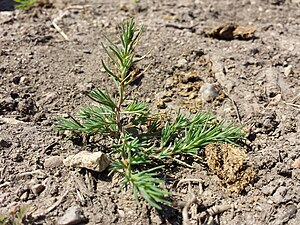Cartilage
| Cartilage | ||||||||||||
|---|---|---|---|---|---|---|---|---|---|---|---|---|

Cartilage ( Polycnemum arvense ), illustration |
||||||||||||
| Systematics | ||||||||||||
|
||||||||||||
| Scientific name | ||||||||||||
| Polycnemum arvense | ||||||||||||
| L. |
The arable illecebrum ( Polycnemum arvense ) is a plant species in the family of amaranthaceae (Amaranthaceae).
description
The cartilage grows as an annual herbaceous plant and reaches heights of 5 to 30 cm. She is a bit hairy at first with simple and branched hair. Their strong stems , branched from the base, are mostly straight in the flower region. The tufted, heaped leaves are up to 10 mm long, sub-needle-shaped and prickly. They are triangular in cross-section, so that a protruding central rib can be seen on the underside of the leaf. The whole plant can be reddish.
The flowers sit individually in the axilla of a bract, which is (rarely two) three to five times as long as the flowers. The two lateral, dry-skinned bracts are about as long as the flowers. The inconspicuous, occasionally reddish flowers are hermaphroditic. The inflorescence consists of five tepals that are only 1 to 1.5 mm long. Usually only three stamens are present. The flowering period extends from July to September.
The fruit remains enclosed by the flower cover. The black and clearly grained seed has a diameter of about 1.2 mm. The ring-shaped embryo surrounds the nutrient tissue.
Photosynthetic pathway
Like all Polycnemum species, Polycnemum arvense is a C 3 plant .
distribution and habitat
Field cartilage is widespread in Central and Southern Europe and Central Asia (as far as Cyprus, Turkey, the Caucasus region, Turkmenistan to Tajikistan). It also occurs as a neophyte in Canada (British Columbia).
It is a pioneer plant on open gravel surfaces, in weed fields of grain fields or in gappy dry grass . In Germany it is regarded as thermophilic characteristic species of Caucalidion Association.
Field cartilage is very rare in Germany and is considered threatened with extinction ( Red List of Endangered Species 1).
Taxonomy
The first publication of Polycnemum arvense took place in 1753 by Carl von Linné in Species Plantarum , 1, p. 35 and at the same time established the genus Polycnemum .
Synonyms of Polycnemum arvense L. are Polycnemum minus J. Lloyd and Polycnemum arvense subsp. minus (Döll) Briq. (nom. inval.).
literature
- Henning Haeupler , Thomas Muer: picture atlas of the fern and flowering plants of Germany (= the fern and flowering plants of Germany. Volume 2). Published by the Federal Agency for Nature Conservation. Ulmer, Stuttgart 2000, ISBN 3-8001-3364-4 , p. 96 Polycnemum arvense .
- IC Hedge: Polycnemum . In: Karl Heinz Rechinger et al. (Ed.): Flora Iranica Volume 172 - Chenopodiaceae . Graz, Akad. Druck, 1997, p. 18. (sections description, distribution, systematics)
Individual evidence
- ↑ Gudrun Kadereit, Thomas Borsch, Kurt Weising & Helmut Freitag: Phylogeny of Amaranthaceae and Chenopodiaceae and the evolution of C 4 photosynthesis . In: International Journal of Plant Sciences , Volume 164 (6), 2003, pp. 959-986. [1]
- ↑ Entry at USDA PLANTS
- ^ Erich Oberdorfer : Plant-sociological excursion flora for Germany and neighboring areas . With the collaboration of Angelika Schwabe and Theo Müller. 8th, heavily revised and expanded edition. Eugen Ulmer, Stuttgart (Hohenheim) 2001, ISBN 3-8001-3131-5 , pp. 341 .
- ↑ Cartilage herb. In: FloraWeb.de.
- ↑ First publication scanned at biodiversitylibrary.org .
- ^ Pertti Uotila, 2011: Chenopodiaceae (pro parte majore) . - In: Euro + Med Plantbase - the information resource for Euro-Mediterranean plant diversity. Polycnemum arvense. Entry at Euro + Med Plantbase .
Web links
- Cartilage. In: FloraWeb.de.
- Distribution map for Germany. In: Floraweb .
- Polycnemum arvense L. In: Info Flora , the national data and information center for Swiss flora . Retrieved October 7, 2015.
- Thomas Meyer: Data sheet with identification key and photos at Flora-de: Flora von Deutschland (old name of the website: Flowers in Swabia )
- Distribution map for Europe
